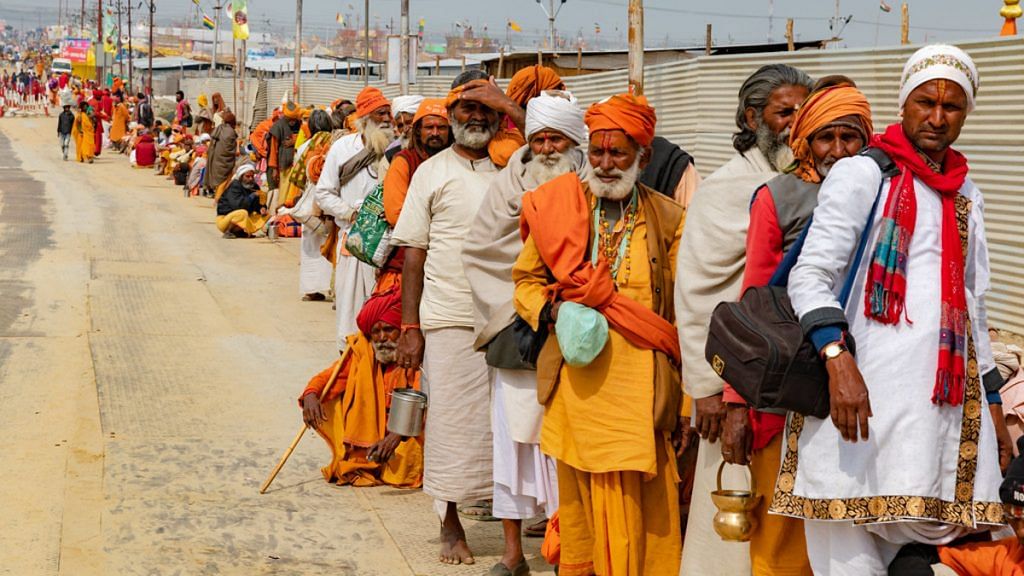New Delhi: Uttarakhand Chief Minister Trivendra Singh Rawat Monday said the Kumbh Mela would be held in its “divine form” in Haridwar next year, despite the practical problems arising out of the Covid-19 pandemic. The mela is scheduled to take place from 11 March to 27 April.
Speaking to ThePrint, Kumbh Mela officer Deepak Rawat said the main priority now was to complete the construction of roads and bridges, as well as beautification of the ghats, especially the Har-Ki-Pauri, by 31 December. Work on nine new ghats, eight bridges and roads are going on.
“How the Kumbh Mela will be conducted and the exact nature of it will be decided in a meeting between the state government and the Akhara Parishad — apex body of the akharas holding the religious congregation — on 15 February,” Deepak said.
A 1,000-bed Covid-19 hospital and a 150-bed non-Covid facility is being set up in Haridwar. Additionally, Deepak said, “border post hospitals” will be set up at bus stands and border areas.
India has the second highest number of Covid-19 cases in the world currently, with more than 91 lakh infections and over 1.3 lakh deaths. Uttarakhand has reported more than 71,000 Covid-19 cases and over 1,100 deaths.
ThePrint explains what is the Kumbh Mela, its importance and the preparations that are taking place for the congregation amid a raging pandemic.
Also read: ULFA-I faces survival test after dy chief’s surrender — All about the rebel outfit in Assam
Legend behind the Kumbh Mela
One of the most noted Hindu religious congregations, the Kumbh Mela is held four times over the course of 12 years. The site of observance rotates between four pilgrimage places on sacred rivers — at Haridwar on the Ganga River, at Ujjain on the Shipra, at Nashik on the Godavari, and at Prayagraj on the confluence of the Ganga, Jamuna, and the Saraswati.
Duration of the Kumbh Mela is believed to be the most auspicious time to take a dip in the Ganga, free oneself of sins and come closer to achieving moksha (salvation).
According to a Hindu legend, gods and demons fought over the sacred kumbh (pitcher) of amrit (nectar), called the ‘Ratna of Samudra Manthan‘. It is believed that the Hindu deity Vishnu took the kumbh away from the demons trying to claim it.
While Vishnu was taking the kumbh to heaven, the amrit fell in four places — Haridwar, Prayagraj, Ujjain and Nashik. The journey to heaven lasted 12 days, which is considered equivalent to 12 human years. Which is why the Kumbh Mela is celebrated over the course of 12 years in these four sites.
Mela amid famines, plague, epidemics & two World Wars
Of the four Kumbh Melas, the Ardh Kumbh, also known as the half Kumbh Mela, is celebrated every six years in either Prayagraj or Haridwar. The Purna Kumbh Mela, also known as the full Kumbh is held every 12 years at either one of the four holy sites (Nashik, Ujjain, Haridwar or Prayagraj). And finally, the Maha Kumbh Mela which is held once in 144 years after the completion of 12 Purna Kumbh Melas is held in Prayagraj.
The first written mention of the Kumbh Mela was in the Bhagavata Purana. Another prominent mention about the mela was made by Hsuan Tsang, a Chinese traveller who had visited India during the reign of Harshavardhana in 629-645 AD.
From 1903, when close to 4,00,000 people attended the Kumbh, 110 years later in 2013, 12 crore had gathered. At the Ardh Kumbh Mela in Allahabad last year, 5 crore pilgrims had taken a dip in the Ganga till 5 pm on 4 February.
The mela has continued despite famines, plague and cholera epidemics and the two World Wars.
Naga sadhus (naked Hindu ascetics) are a huge draw at the Kumbh Melas. They are among the first to take a holy dip (shahi snan) and their charge down to the waters to bathe at the opening of the Kumbh Mela is one of the main highlights of the religious gathering.
Also read: All about La Niña, reason why India could have a colder winter than usual this year
2021 Kumbh Mela in Haridwar
The 2021 Kumbh Mela will be taking place in Haridwar after a gap of 11 years. It was last held in 2010.
Dr Jugal Kishore, vice president of the Indian Association of Epidemiologists and a public health expert told ThePrint that till a vaccine was not in circulation and the coronavirus under control, religious processions should be delayed as they divert funds and resources away from Covid-19 relief.
“We can celebrate them next year or sometime in the future as well. How will it help the situation now? Covid-19 is here to stay for a while and till then, such congregations are not a good idea,” said Dr Kishore.
He also said that though all plans were in place, the ground realities and how things actually take place are very different. “You are managing the Kumbh Mela for now, but who monitors what happens afterwards?”
The mela was supposed to take place in 2022 but was advanced due to “auspicious dates”. Mahant Narendra Giri, head of the Akhil Bharatiya Akhara Parishad, which is part of the 2021 Kumbh Mela preparations, said, “After more than 100 years, the Kumbh Mela will be held earlier. It is happening because of specific auspicious dates.”
For a holy dip in the Ganga, held on four specific days, pilgrims will have to register on a website in advance for a specific ghat to bathe in. Each pilgrim will be given a certain amount of time to visit the ghats and only 15 minutes for the holy dip.
Uttarakhand Urban Development Minister Madan Kaushik has said that 35 to 50 lakh people are expected to take a holy dip in the Ganga every day during the Kumbh Mela next year.
Also read: Why Indian app developers are most vocal in resisting Google’s 30% ‘gatekeeper’s fee’
